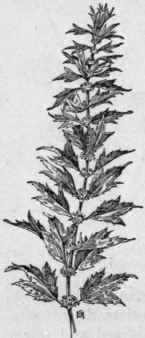Motherwort Leonurus Cardiaca, L. Lion's-tail, Lion's-ear, Cowthwort
Description
This section is from the book "A Manual Of Weeds", by Ada E. Georgia. Also available from Amazon: A Manual Of Weeds.
Motherwort Leonurus Cardiaca, L. Lion's-tail, Lion's-ear, Cowthwort
Introduced. Perennial. Propagates by seeds.
Time of bloom: June to September.
Seed-time: August to November.
Range: Nova Scotia to Minnesota and Nebraska, southward to North Carolina.
Habitat: About dwellings and in barnyards; on roadsides; a frequent tenant of vacant city lots.
One of the social, half-domesticated weeds, seldom found far from men's habitations; it is medicinally valuable, the dried leaves and tops being worth three to five cents a pound in the drug market.
Stem two to five feet tall, rather stout, square, with a few ascending branches. Leaves dark green, thin, finely rough-hairy; the lower ones rounded, palmately lobed, usually five-pointed, often three or four inches broad; higher up they become three-lobed and near the top they are often lance-shaped; all with slender petioles. Flowers in crowded axillary whorls, pink, pale purple, or white, the corolla with its curving upper lip bearded outside, the lower one three-lobed and purple-dotted; stamens ascending against the upper lip, the lower pair the longer. Calyx hairy, with five awl-like points which become hard and rigid; each contains four small, brown, three-angled nutlets with blunt or truncate apex tipped with fine, short, bristly hairs. (Fig. 247.)

Fig. 247.- Motherwort (Leonurus Cardi-aca). X 1/4
Means Of Control
Deep cutting with hoeror spud before any seed has matured, using dry salt on the shorn surfaces for the purpose of checking new growth.
Continue to:


